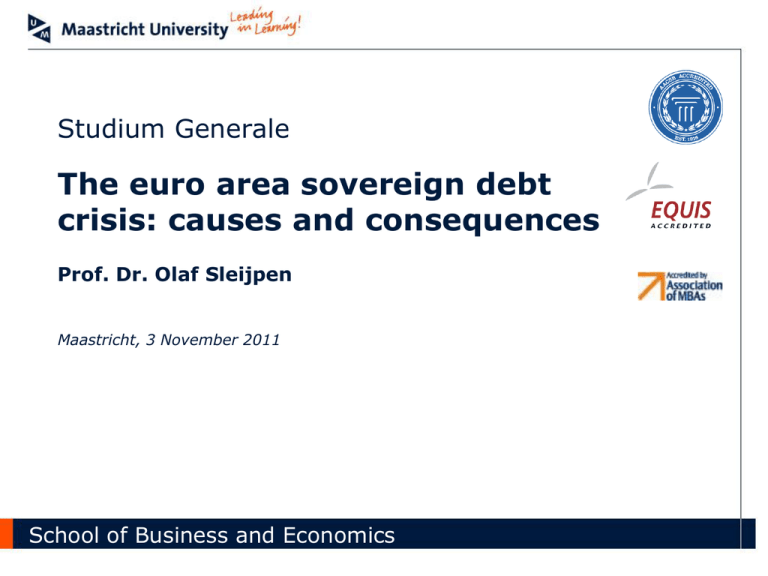An assessment of the economic
advertisement

Studium Generale The euro area sovereign debt crisis: causes and consequences Prof. Dr. Olaf Sleijpen Maastricht, 3 November 2011 School of Business and Economics Agenda 1) A short (conceptual) history of European monetary integration 2) Fiscal discipline in the Treaty 3) Evidence of fiscal discipline in the euro area 4) Lessons to be drawn: the inconsistent triangle revisited 5) A new perspective on nominal and real convergence in the euro area 6) An assessment of the euro area summit of 23 October 7) Concluding remarks School of Business and Economics A short (conceptual) history of European monetary integration Maastricht Treaty “Big Bang” approach -Nominal convergence required; No real convergence -Strongly embedded monetary policy structure in place -Intergovernmental framework to impose fiscal discipline; no framework to impose real convergence -Convergence will follow automatically after Start monetary union -Discipline imposed by fixed exchange rates will trigger nominal and real economic discipline Economic and Monetary Union School of Business and Economics Convergence approach -Inspired by Optimal Currency Area theory -Full nominal and real convergence required -Appropriate adjustment mechanisms in place in case of (asymmetric) shocks -Monetary union is the “crown” on convergence process Why fiscal discipline matters in a monetary union • • • • • Preventing spillovers from fiscal to monetary policy Preventing spillovers from national fiscal policies to other Member States Absorption of asymmetric shocks at the national level Market discipline flawed Macro-economic and financial stability School of Business and Economics Fiscal discipline in the Maastricht Treaty • • • • Multilateral surveillance procedure Excessive deficit procedure Prohibition of priviliged access No bail-out clause School of Business and Economics The Stability and Growth Pact Revisited • Adopted in 1997 (Amsterdam European Council) • Reform in 2004 • Preventive arm – Strengthening of the surveillance of budgetary positions and the surveillance and coordination of economic policies • Corrective arm – Speeding up and clarifying the implementation of the excessive deficit procedure School of Business and Economics Insufficient compliance … % GDP 2 00 0 99 -2 01 02 98 07 03 04 06 08 05 -4 09 -6 -8 97 99 Programme year 01 03 Realisation 05 07 09 Spring Forecast Source: European Commission, Spring Forecasts 2010 and budgetary plans according to national budgets. School of Business and Economics 11 …became apparent during the crisis Budget deficit % of GDP 5 0 -5 -10 -15 96 98 Germany Netherlands 00 02 France Greece 04 Italy Portugal School of Business and Economics Source: European Commission, Spring Forecasts, 2010. 06 08 Spain Ireland 10 Increase in debt… Gross public debt euro area % of GDP 90 80 70 60 94 99 04 School of Business and Economics Source: European Commission, Spring Forecasts 2010. 09 …and late market reaction Interest rate spread with German government debt (10-year maturity) % points 10 8 6 4 2 0 -2 96 98 00 02 04 06 France Italy Spain Greece Portugal Ireland School of Business and Economics Source: Thomson Financial. 08 10 Netherlands Consequence: financial stability risk in EMU Government debt held by non-residents (% of total) DE FR IT ES NL GR PT IE 1998 33.8 50.9 26.9 24.2 19.5 29.3 37.9 na 2004 42.7 46.0 38.6 47.3 52.9 53.4 56.4 58.7 2008 49.6 55.6 42.3 45.9 65.5 na 77.1 72.7 School of Business and Economics Source: Eurostat and CBS (for The Netherlands). The (new) inconsistent triangle • The inconsistent triangle (Padoa-Schioppa, 1985) – Incompatibility between fixed but adjustable exchange rates, full capital mobility and independent monetary policies – This inconsistent triangle prooved to be true in the EMS Crisis (1992-1993) • The new inconsistent triangle – Incompatibility between single monetary policy, full capital mobility and independent fiscal policies – Reflected by the current crisis in the euro area School of Business and Economics What doe this inconsistent triangle imply? • Fiscal consolidation is necessary, but will take time – And will not reassure financial markets in the short term • If the (new) inconsistent triangle is true, a major overhaul of the institutional set-up of the euro area is necessary • A major reform of the institutional set-up may not sooth financial markets – Enlarged and flexible EFSF as temporary solution School of Business and Economics Strengthening economic governance – the view of the EU • • • • • Towards greater fiscal discipline Broadening economic surveillance: a new surveillance mechanism Deeper and broader coordination: the “European Semester” Robust framework for crisis management Stronger institutions for more effective economic governance School of Business and Economics The importance of enhancing national fiscal rules and frameworks 1.50 FI Error Surplus Adjustment 1.00 SE DK 0.50 ES IE AT 0.00 0.00 0.20 -0.50 NL BE 0.40 IT 0.60 FR 0.80 1.00 1.20 DE UK PT EL -1.00 FISRUL Relationship between plausibility of projections stability programmes and national fiscal rules, after taking into account other explanatory variables. School of Business and Economics Source: Beetsma, Giuliodori and Wierts (2009, Economic Policy) More focus on debt financing 800 Short-term government debt outstanding (central government) 14 700 12 600 10 500 8 400 6 300 4 200 2 99 Bn euro 01 03 % GDP (right scale) 05 07 % Share in total debt (right scale) School of Business and Economics Source: Hoogduin, Öztürk and Wierts (2010). 09 An assessment of the economic (fiscal) governance • Excessive deficit and follow-up should be called by Community institution – Framework should become less intergovernmental • Sanctions should be efficient and effective – Value-added of fines, etc. is limited • Financial support limited to strong conditionality School of Business and Economics Economic convergence revisited • Nominal convergence (interest rate, inflation, public finance) • Real convergence (labour) market flexibility (assymetric) shock absorption by national budgets (automatic stabilisers) School of Business and Economics Inflation euro area: low and stable… Inflation euro area % changes (y-o-y) 5 4 3 2 1 0 -1 91 96 01 School of Business and Economics Source: Thomson Financial. 06 …but inflation differentials persistent Inflation (HICP) % changes (y-o-y) 6 3 0 -3 99 01 Germany 03 France Netherlands Greece 05 Italy Portugal School of Business and Economics Source: Thomson Financial. 07 09 Spain Ireland Imbalances have increased Current account balance % euro area or world GDP 6 3 4 2 2 1 0 0 -2 -1 -4 -2 91 93 95 97 99 01 03 05 Deficit countries euro area Surplus countries euro area Deficit countries - global (right-hand axis) Surplus countries - global (right-hand axis) School of Business and Economics Source: IMF. 07 09 Causes imbalances % GDP and % changes 20 10 0 -10 -20 LUX NL D FI BE AT EMU IT FR IRL PT Current account balance Average increase house prices 2000 -2007 Change real effective exchange rate 1997-2007 (GDP deflator) School of Business and Economics Source: European Commission. SP GR Budget periphery more affected Average deterioration of the budgetary position A. Other EMU countries Before crisis After crisis 4 (Autumn 2007) (Spring 2010) 4 0 0 -4 -4 -8 -8 -12 -12 2007 2009 Actual deficit 2007 B. Portugal, Ireland, Italy, Greece and Spain Before crisis After crisis (Autumn 2007) (Spring 2010) 2009 Structural deficit 2007 Actual deficit School of Business and Economics Source: European Commission, Economic forecasts. 2009 2007 2009 Structural deficit Crisis reveals relationship imbalances and budgetary position Structural budget deficit 2007 5 0 -5 -10 R2 = 0,1647 -15 -20 -15 -10 -5 0 5 10 15 After crisis (Spring 2010) Structurak budget deficit 2009 Before crisis (Autumn 2007) 5 0 -5 -10 R2 = 0,6034 -15 -20 -15 -10 -5 Current account balance 2007 School of Business and Economics Source: European Commission, Economic forecasts. 0 5 10 15 Current account balance 2007 What has been agreed on 23 October? European Council • Banking package Euro Summit • Sustainable public finances and structural reform • Refining the Greek programme – Monitoring – PSI and credit enhancement • EFSF – Leverage resources of the EFSF • Economic governance School of Business and Economics Assessment of the 23 October package Pro’s • Increase in “fire power” of the EFSF • Package necessary to sooth markets • Further enhancement of economic governance Con’s • PSI not clear • Leverage: will it work? • Enhanced economic convergence: not enough? • Implementation lag School of Business and Economics Concluding remarks • Financial crisis has revealed weak compliance with and enforcement of fiscal and economic policy rules in EMU • Insufficient fiscal discipline; insufficient real convergence • “Every cloud has a silver lining”: broadening and deepening of policy framework necessary – But more ambition necessary School of Business and Economics









